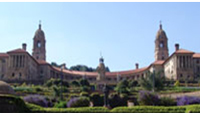This Day in History: November 26, 1910
Additional Date: November 26, 1910
The Union Buildings is the seat of the South African government and is situated in the capital city, Pretoria, now known as Tshwane. It was designed by Sir Herbert Baker in 1908 and the building process began in 1909. On 26 November, 1910, the cornerstone was laid, with completion intended for 1913. The construction of the Union Buildings took approximately 1265 artisans and laborers. Almost fourteen million bricks were used for the interior office walls. South African stone was used throughout the building, with most of the mountain stone quarried on the site. The hill on which the building was constructed was initially owned by Andries Francois du Toit, Pretoria's first Magistrate. He then sold the land to Stephanus Jacobus Meintjies, after whom the hill is named (Meintjieskop).
The Union Buildings was commissioned as part of the establishment of the Union of South Africa. Prior to this, South Africa had been divided into two British colonies and two independent Boer republics, which were all unified into one country after the Anglo Boer War. The two wings of the building are joined, symbolizing the unification of a divided people. From the mid-twentieth century, the Union Buildings served as a location for political protests, particularly during apartheid. One of the most well-known marches on the Union Buildings was the 1956 Women's March protesting against proposed passes for black women. Since South Africa's emergence as a democracy, the Union Buildings is a location used to commemorate historical eventsas well as to celebrate South Africa's heritage.
Tourists to Pretoria frequently visit the Union Buildings and enjoy viewing the war memorial, statues, sprawling gardens (planted with only indigenous plants) and the breathtaking view over the city.
